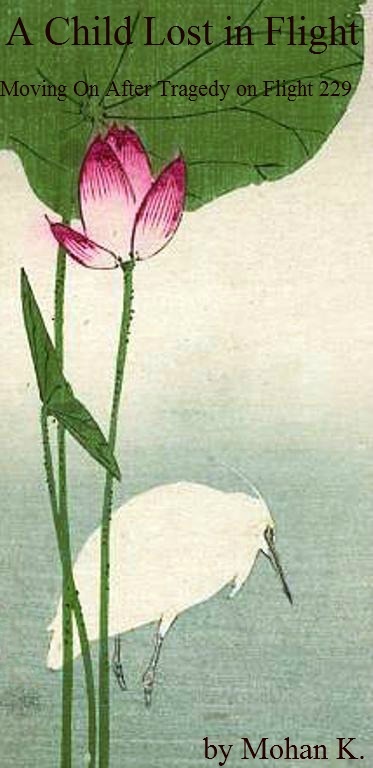 Today’s post is by Susan Bailey, a faithful reader of this blog (you may recognize her name from her many thoughtful comments). Her contribution describes a book that touched her heart:
Today’s post is by Susan Bailey, a faithful reader of this blog (you may recognize her name from her many thoughtful comments). Her contribution describes a book that touched her heart:
Death can be sudden and random, and grief’s journey capricious. Yet if we allow ourselves to be swept along in the journey, it can be transforming.
Mohan K. describes his grief journey after the random death of his healthy four month-old son; it is called A Child Lost in Flight : Moving on after tragedy on Flight 229.
A short narrative of 57 pages, A Child Lost in Flight moves with urgency causing this normally ponderous reader to fly through the pages, anxious to find out what happened to this family. The author’s simple, transparent prose disappeared behind the quick flow of the story.
A Child Lost in Flight is the story of a young Indian couple, Mohan and Suja, who lose their healthy 4-1/2 month-old son on an international flight to Delhi. For no apparent reason, little Aditya turns blue and stops breathing while nursing from his mother during the flight’s descent.
Mohan begins the story in the present, nearly a year after his son’s death. Tears pour forth unexpectedly while driving to work as a simple song reminds him of his son. Titled “Preamble,” the chapter summarizes the grief journey his wife Suja and he have been on, setting the stage for the story.
Mohan and Suja joyfully anticipate the arrival of their son, Aditya. Mohan takes a very hands-on approach to the whole experience, beginning with his support of Suja during the long birth process, and continuing with his active involvement in the child’s day-to-day care. Because of this involvement, Mohan admits, “I was intensely attached to the little guy.”
Mohan and Suja soon discover that living in Canada, far away from their immediate families in India is, no longer desirable. The complex arrangements are made and they begin their long journey from Toronto to Delhi.
Mohan and Suja consulted with the baby’s doctor before departure, making sure they were taking every precaution to insure Aditya’s safety. Feeling secure in their decision, the family begins the series of long flights, never suspecting the calamity that would befall them.
Mohan’s clear and concise narrative moves now with greater urgency. No clue is given as to how the child would die; when he does, it is shocking in its utter randomness. Taut descriptions of the inexperienced crew, the mistakes made and the precious time lost create an oppressive sense of helplessness.
The lack of compassion and involvement, coupled with clear ineptitude and endless bureaucracy on the part of the airline (Jet Airways), airport officials, the police inspector and medical officials at the morgue add to this sense of powerlessness. Mohan clearly admits to his confusion and inability to get the answers he needed.
After gathering himself, Mohan embarks on an ultimately fruitless search for answers, filing a detailed report with the airline but coming up empty. A copy of his letter and the airline’s response clearly illustrates that the death of a human being has been forgotten in sea of bureaucracy.
It was at this point in the story where I was surprised and encouraged by the resiliency of this couple. Finding no real help from family, friends, self-help books and online forums, or their Hindu religion, Mohan and Suja wisely begin to give in to the flow of their grief’s journey, moving away to Switzerland to start a new life.
By agreeing together to go on the journey, Mohan and Suja preserve their marital relationship, drawing closer to each another. Many marriages cannot withstand the stress brought on by a child’s death; Mohan and Suja were fortunate. Mohan refers several times to the “blessing” of “being in the present,” thus showing insight and an acceptance of where they were at, with a willingness to be led forward.
Mohan cited a particularly helpful book by Elizabeth Gilbert entitled Eat, Pray Love. He writes:
Gilbert’s cheery narrative of how she broke through the gloom and despair of divorce and her lost dreams by following her dream: spending a year eating, loving, and praying, moving across continents to focus on herself to reflect and recharge resonated with me. Wasn’t this also the situation Suja and I had found ourselves in? There was a distinct pattern in the book that resonated with me.
Remaining in the present, allowing oneself to recharge, to breathe … this, to me, speaks of someone open to the flow of life’s journey, through the tumultuous to the hope of a new place. Mohan and Suja were open to transformation, the healing power of allowing grief to take its course.
As a spiritually-minded person who has found my faith in God a vital part of the healing process during my own periods of grief, I believe that God manifests Himself directly or indirectly, to each individual, according to that individual’s needs. I see a guiding hand in Mohan and Suja’s journey, one that for them that leads to new life and new joys for them as a family.
There is much wisdom in A Child Lost in Flight that can apply just as easily to people of faith as to people with little or no faith. Little Aditya will never be forgotten but his memory can serve as a reminder and a guide to this couple of life, death and renewal: the most basic, and most profound of mysteries.











